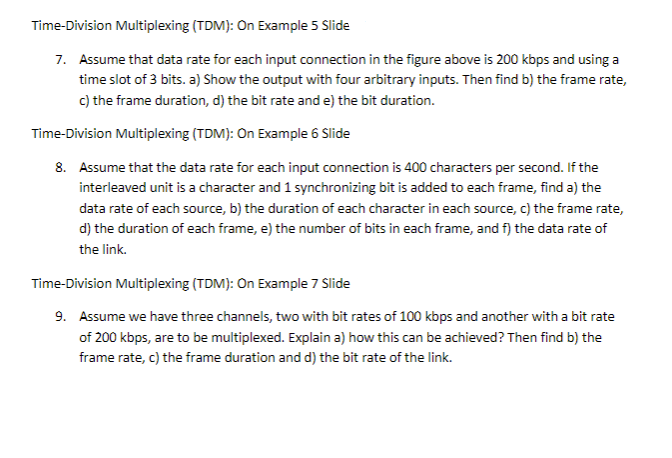9. Assume we have three channels, two with bit rates of 100 kbps and another with a bit rate of 200 kbps, are to be multiplexed. Explain a) how this can be achieved? Then find b) the frame rate, c) the frame duration and d) the bit rate of the link.
9. Assume we have three channels, two with bit rates of 100 kbps and another with a bit rate of 200 kbps, are to be multiplexed. Explain a) how this can be achieved? Then find b) the frame rate, c) the frame duration and d) the bit rate of the link.
Computer Networking: A Top-Down Approach (7th Edition)
7th Edition
ISBN:9780133594140
Author:James Kurose, Keith Ross
Publisher:James Kurose, Keith Ross
Chapter1: Computer Networks And The Internet
Section: Chapter Questions
Problem R1RQ: What is the difference between a host and an end system? List several different types of end...
Related questions
Question
Q9 no handwriting please

Transcribed Image Text:Time-Division Multiplexing (TDM): On Example 5 Slide
7. Assume that data rate for each input connection in the figure above is 200 kbps and using a
time slot of 3 bits. a) Show the output with four arbitrary inputs. Then find b) the frame rate,
c) the frame duration, d) the bit rate and e) the bit duration.
Time-Division Multiplexing (TDM): On Example 6 Slide
8. Assume that the data rate for each input connection is 400 characters per second. If the
interleaved unit is a character and 1 synchronizing bit is added to each frame, find a) the
data rate of each source, b) the duration of each character in each source, c) the frame rate,
d) the duration of each frame, e) the number of bits in each frame, and f) the data rate of
the link.
Time-Division Multiplexing (TDM): On Example 7 Slide
9. Assume we have three channels, two with bit rates of 100 kbps and another with a bit rate
of 200 kbps, are to be multiplexed. Explain a) how this can be achieved? Then find b) the
frame rate, c) the frame duration and d) the bit rate of the link.
Expert Solution
This question has been solved!
Explore an expertly crafted, step-by-step solution for a thorough understanding of key concepts.
This is a popular solution!
Trending now
This is a popular solution!
Step by step
Solved in 2 steps

Recommended textbooks for you

Computer Networking: A Top-Down Approach (7th Edi…
Computer Engineering
ISBN:
9780133594140
Author:
James Kurose, Keith Ross
Publisher:
PEARSON

Computer Organization and Design MIPS Edition, Fi…
Computer Engineering
ISBN:
9780124077263
Author:
David A. Patterson, John L. Hennessy
Publisher:
Elsevier Science

Network+ Guide to Networks (MindTap Course List)
Computer Engineering
ISBN:
9781337569330
Author:
Jill West, Tamara Dean, Jean Andrews
Publisher:
Cengage Learning

Computer Networking: A Top-Down Approach (7th Edi…
Computer Engineering
ISBN:
9780133594140
Author:
James Kurose, Keith Ross
Publisher:
PEARSON

Computer Organization and Design MIPS Edition, Fi…
Computer Engineering
ISBN:
9780124077263
Author:
David A. Patterson, John L. Hennessy
Publisher:
Elsevier Science

Network+ Guide to Networks (MindTap Course List)
Computer Engineering
ISBN:
9781337569330
Author:
Jill West, Tamara Dean, Jean Andrews
Publisher:
Cengage Learning

Concepts of Database Management
Computer Engineering
ISBN:
9781337093422
Author:
Joy L. Starks, Philip J. Pratt, Mary Z. Last
Publisher:
Cengage Learning

Prelude to Programming
Computer Engineering
ISBN:
9780133750423
Author:
VENIT, Stewart
Publisher:
Pearson Education

Sc Business Data Communications and Networking, T…
Computer Engineering
ISBN:
9781119368830
Author:
FITZGERALD
Publisher:
WILEY